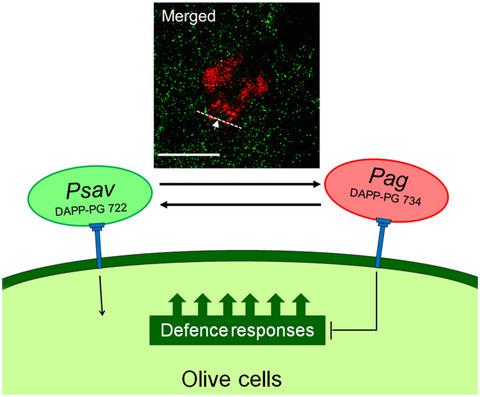当前位置:
X-MOL 学术
›
Mol. Plant Pathol.
›
论文详情
Our official English website, www.x-mol.net, welcomes your
feedback! (Note: you will need to create a separate account there.)
Synergistic interaction between the type III secretion system of the endophytic bacterium Pantoea agglomerans DAPP-PG 734 and the virulence of the causal agent of olive knot Pseudomonas savastanoi pv. savastanoi DAPP-PG 722
Molecular Plant Pathology ( IF 4.8 ) Pub Date : 2021-07-16 , DOI: 10.1111/mpp.13105 Chiaraluce Moretti 1 , Fabio Rezzonico 2 , Benedetta Orfei 1 , Chiara Cortese 1 , Alba Moreno-Pérez 3, 4 , Harrold A van den Burg 5 , Andrea Onofri 1 , Giuseppe Firrao 6 , Cayo Ramos 3, 4 , Theo H M Smits 2 , Roberto Buonaurio 1
Molecular Plant Pathology ( IF 4.8 ) Pub Date : 2021-07-16 , DOI: 10.1111/mpp.13105 Chiaraluce Moretti 1 , Fabio Rezzonico 2 , Benedetta Orfei 1 , Chiara Cortese 1 , Alba Moreno-Pérez 3, 4 , Harrold A van den Burg 5 , Andrea Onofri 1 , Giuseppe Firrao 6 , Cayo Ramos 3, 4 , Theo H M Smits 2 , Roberto Buonaurio 1
Affiliation

|
The endophytic bacterium Pantoea agglomerans DAPP-PG 734 was previously isolated from olive knots caused by infection with Pseudomonas savastanoi pv. savastanoi DAPP-PG 722. Whole-genome analysis of this P. agglomerans strain revealed the presence of a Hypersensitive response and pathogenicity (Hrp) type III secretion system (T3SS). To assess the role of the P. agglomerans T3SS in the interaction with P. savastanoi pv. savastanoi, we generated independent knockout mutants in three Hrp genes of the P. agglomerans DAPP-PG 734 T3SS (hrpJ, hrpN, and hrpY). In contrast to the wildtype control, all three mutants failed to cause a hypersensitive response when infiltrated in tobacco leaves, suggesting that P. agglomerans T3SS is functional and injects effector proteins in plant cells. In contrast to P. savastanoi pv. savastanoi DAPP-PG 722, the wildtype strain P. agglomerans DAPP-PG 734 and its Hrp T3SS mutants did not cause olive knot disease in 1-year-old olive plants. Coinoculation of P. savastanoi pv. savastanoi with P. agglomerans wildtype strains did not significantly change the knot size, while the DAPP-PG 734 hrpY mutant induced a significant decrease in knot size, which could be complemented by providing hrpY on a plasmid. By epifluorescence microscopy and confocal laser scanning microscopy, we found that the localization patterns in knots were nonoverlapping for P. savastanoi pv. savastanoi and P. agglomerans when coinoculated. Our results suggest that suppression of olive plant defences mediated by the Hrp T3SS of P. agglomerans DAPP-PG 734 positively impacts the virulence of P. savastanoi pv. savastanoi DAPP-PG 722.
中文翻译:

内生细菌 Pantoea agglomerans DAPP-PG 734 的 III 型分泌系统与橄榄结 Pseudomonas savastanoi pv. 致病因子的毒力之间的协同相互作用。savastanoi DAPP-PG 722
内生细菌Pantoea agglomerans DAPP-PG 734 以前是从由Pseudomonas savastanoi pv.感染引起的橄榄结中分离出来的。savastanoi DAPP-PG 722. 该P. agglomerans菌株的全基因组分析显示存在过敏反应和致病性( Hrp ) III 型分泌系统 (T3SS)。评估P. agglomerans T3SS 在与P相互作用中的作用。 savastanoi pv. savastanoi ,我们在P. agglomerans的三个Hrp基因中产生了独立的敲除突变体DAPP-PG 734 T3SS(hrpJ、hrpN和hrpY)。与野生型对照相比,所有三种突变体在渗入烟草叶时均未引起过敏反应,这表明P. agglomerans T3SS 具有功能性并将效应蛋白注入植物细胞中。与P相比。savastanoi pv. savastanoi DAPP-PG 722 , 野生型菌株P。agglomerans DAPP-PG 734 及其Hrp T3SS 突变体不会在 1 年生的橄榄植物中引起橄榄结病。P的共接种。 savastanoi pv. 萨瓦斯塔诺伊P. agglomerans野生型菌株没有显着改变结大小,而 DAPP-PG 734 hrpY突变体诱导结大小显着减小,这可以通过在质粒上提供hrpY来补充。通过落射荧光显微镜和共聚焦激光扫描显微镜,我们发现结中的定位模式对于P是不重叠的。 savastanoi pv. savastanoi和P. agglomerans当共同接种时。我们的研究结果表明,抑制由P. agglomerans DAPP-PG 734 的Hrp T3SS介导的橄榄植物防御会对P.的毒力产生积极影响。 savastanoi pv. savastanoi DAPP-PG 722。
更新日期:2021-09-12
中文翻译:

内生细菌 Pantoea agglomerans DAPP-PG 734 的 III 型分泌系统与橄榄结 Pseudomonas savastanoi pv. 致病因子的毒力之间的协同相互作用。savastanoi DAPP-PG 722
内生细菌Pantoea agglomerans DAPP-PG 734 以前是从由Pseudomonas savastanoi pv.感染引起的橄榄结中分离出来的。savastanoi DAPP-PG 722. 该P. agglomerans菌株的全基因组分析显示存在过敏反应和致病性( Hrp ) III 型分泌系统 (T3SS)。评估P. agglomerans T3SS 在与P相互作用中的作用。 savastanoi pv. savastanoi ,我们在P. agglomerans的三个Hrp基因中产生了独立的敲除突变体DAPP-PG 734 T3SS(hrpJ、hrpN和hrpY)。与野生型对照相比,所有三种突变体在渗入烟草叶时均未引起过敏反应,这表明P. agglomerans T3SS 具有功能性并将效应蛋白注入植物细胞中。与P相比。savastanoi pv. savastanoi DAPP-PG 722 , 野生型菌株P。agglomerans DAPP-PG 734 及其Hrp T3SS 突变体不会在 1 年生的橄榄植物中引起橄榄结病。P的共接种。 savastanoi pv. 萨瓦斯塔诺伊P. agglomerans野生型菌株没有显着改变结大小,而 DAPP-PG 734 hrpY突变体诱导结大小显着减小,这可以通过在质粒上提供hrpY来补充。通过落射荧光显微镜和共聚焦激光扫描显微镜,我们发现结中的定位模式对于P是不重叠的。 savastanoi pv. savastanoi和P. agglomerans当共同接种时。我们的研究结果表明,抑制由P. agglomerans DAPP-PG 734 的Hrp T3SS介导的橄榄植物防御会对P.的毒力产生积极影响。 savastanoi pv. savastanoi DAPP-PG 722。











































 京公网安备 11010802027423号
京公网安备 11010802027423号